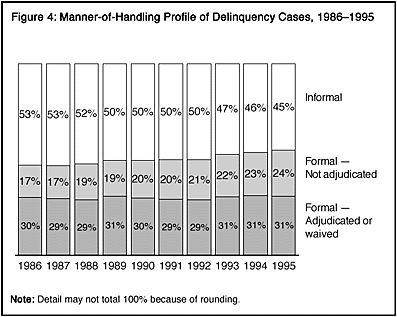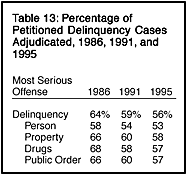|
Judicial Decision and Disposition Adjudication The proportion of petitioned delinquency cases in which the juvenile was adjudicated delinquent decreased from 64% to 56% between 1986 and 1995. The percentage of petitioned cases that resulted in adjudication decreased from 58% to 53% for person offense cases, from 66% to 58% for property offense cases, from 68% to 57% for drug offense cases, and from 66% to 57% for public order offense cases. Although adjudications declined as a percentage of formally handled delinquency cases between 1986 and 1995, when adjudications and transfers to criminal court are measured as a proportion of all delinquency cases, the practices of juvenile courts are found to have changed very little between 1986 and 1995 (figure 4). During the 10-year period, cases resulting in transfer or adjudication have accounted for 3 in 10 delinquency cases. What changed between 1986 and 1995 is the use of formal processing; the proportion of cases petitioned increased considerably during that time. 
|
 A youth may be adjudicated delinquent after admitting to the charges in a case or after the court finds sufficient evidence to judge the youth a delinquent. Juveniles were adjudicated delinquent by the court in 56% of all formally processed delinquency cases in 1995 (table 13). Among formally handled delinquency cases in 1995, 53% of person offense cases were adjudicated, as were 58% of property offense cases, 57% of drug law violation cases, and 57% of public order offense cases.
A youth may be adjudicated delinquent after admitting to the charges in a case or after the court finds sufficient evidence to judge the youth a delinquent. Juveniles were adjudicated delinquent by the court in 56% of all formally processed delinquency cases in 1995 (table 13). Among formally handled delinquency cases in 1995, 53% of person offense cases were adjudicated, as were 58% of property offense cases, 57% of drug law violation cases, and 57% of public order offense cases.